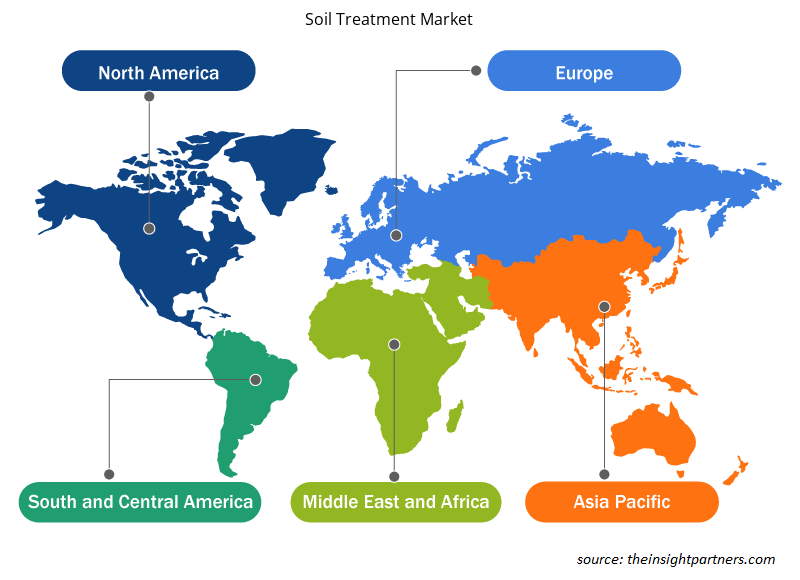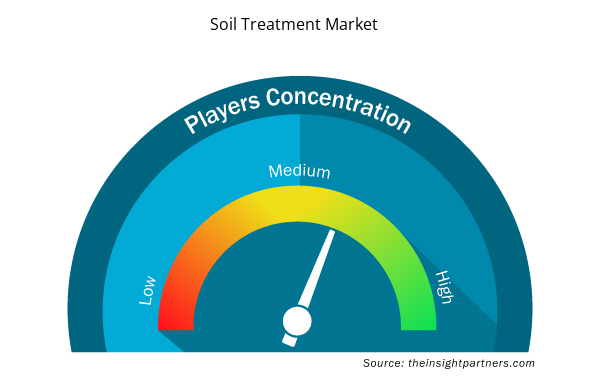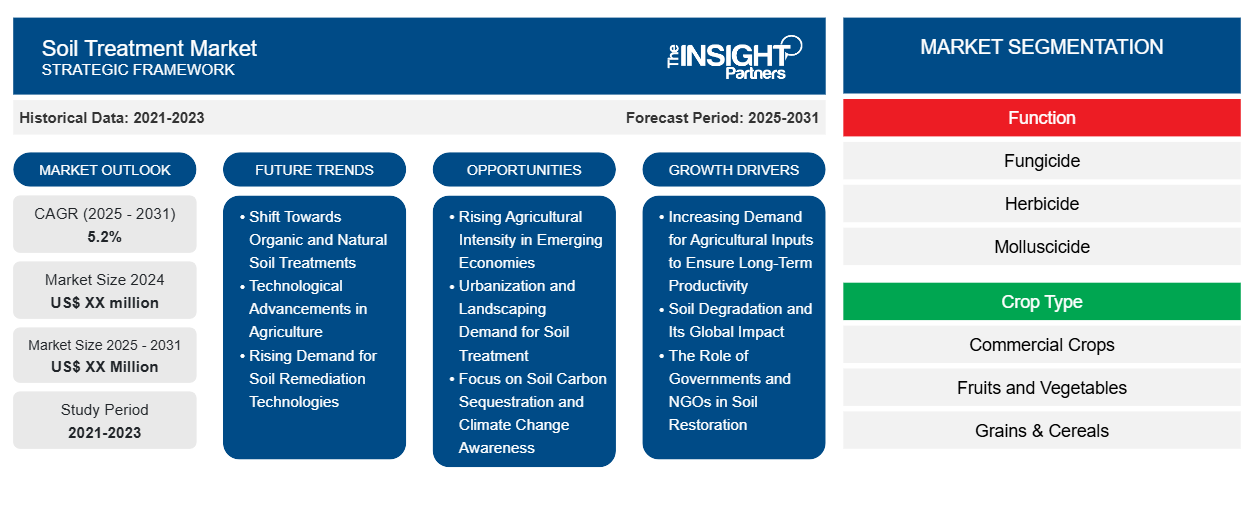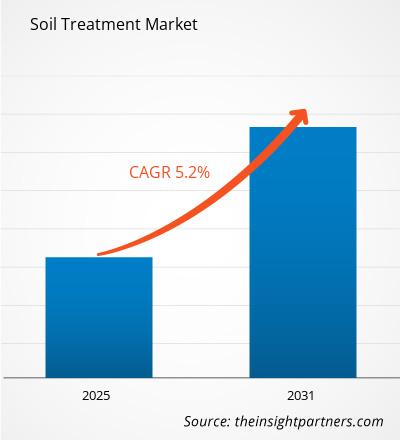من المتوقع أن يسجل سوق معالجة التربة معدل نمو سنوي مركب بنسبة 5.2٪ من عام 2024 إلى عام 2031، مع توسع حجم السوق من XX مليون دولار أمريكي في عام 2024 إلى XX مليون دولار أمريكي بحلول عام 2031.
تم تقسيم التقرير حسب الوظيفة (مبيدات الفطريات، ومبيدات الأعشاب، ومبيدات الرخويات، ومبيدات الحشرات، ومبيدات النيماتودا). كما يقدم التقرير تحليلاً يعتمد على نوع المحصول (المحاصيل التجارية، والفواكه والخضروات، والحبوب، والبقوليات والبذور الزيتية، والعشب والنباتات الزينة). ويغطي نطاق التقرير خمس مناطق: أمريكا الشمالية، وأوروبا، وآسيا والمحيط الهادئ، والشرق الأوسط وأفريقيا، وأمريكا الجنوبية والوسطى، والدول الرئيسية في كل منطقة. كما تم تقسيم التحليل العالمي على المستوى الإقليمي والدول الرئيسية. ويقدم التقرير القيمة بالدولار الأمريكي للتحليل والشرائح المذكورة أعلاه.
غرض التقرير
يهدف تقرير سوق معالجة التربة الصادر عن The Insight Partners إلى وصف المشهد الحالي والنمو المستقبلي وأهم العوامل الدافعة والتحديات والفرص. وسيوفر هذا رؤى لمختلف أصحاب المصلحة في الأعمال التجارية، مثل:
- مزودي/مصنعي التكنولوجيا: لفهم ديناميكيات السوق المتطورة ومعرفة فرص النمو المحتملة، وتمكينهم من اتخاذ قرارات استراتيجية مستنيرة.
- المستثمرون: إجراء تحليل شامل للاتجاهات فيما يتعلق بمعدل نمو السوق، وتوقعات السوق المالية، والفرص المتاحة عبر سلسلة القيمة.
- الهيئات التنظيمية: لتنظيم السياسات ومراقبة الأنشطة في السوق بهدف تقليل الانتهاكات والحفاظ على ثقة المستثمرين والحفاظ على سلامة السوق واستقرارها.
تجزئة سوق معالجة التربة
وظيفة
- مبيد الفطريات
- مبيد الأعشاب
- مبيد الرخويات
- مبيد حشري
- مبيد النيماتودا
نوع المحصول
- المحاصيل التجارية
- الفواكه والخضروات
- الحبوب والبذور
- البقوليات والبذور الزيتية
- العشب والزينة
قم بتخصيص هذا التقرير ليناسب متطلباتك
ستحصل على تخصيص لأي تقرير - مجانًا - بما في ذلك أجزاء من هذا التقرير، أو تحليل على مستوى الدولة، وحزمة بيانات Excel، بالإضافة إلى الاستفادة من العروض والخصومات الرائعة للشركات الناشئة والجامعات
- احصل على أهم اتجاهات السوق الرئيسية لهذا التقرير.ستتضمن هذه العينة المجانية تحليلاً للبيانات، بدءًا من اتجاهات السوق وحتى التقديرات والتوقعات.
عوامل نمو سوق معالجة التربة
- الطلب المتزايد على المدخلات الزراعية لضمان الإنتاجية على المدى الطويل: مع تزايد عدد سكان العالم، فإن الحاجة إلى المنتجات الزراعية تتطلب مدخلات أعلى في التربة للمعالجة المناسبة لضمان الإنتاجية الزراعية على المدى الطويل وتوافر إنتاج غذائي مستدام. يعد التسميد وتعديل درجة الحموضة والتعديلات العضوية المستخدمة في معالجة التربة أمرًا بالغ الأهمية لأنها تؤثر على صحة التربة وتعظيم إنتاج المحاصيل وضمان الإنتاجية الزراعية على المدى الطويل وتعزيز الإنتاج. يتطلب الإنتاج الزراعي المرتفع حلاً أكثر كفاءة لمعالجته.
- تدهور التربة وتأثيره العالمي: إن الإفراط في استخدام الأراضي الزراعية، وإزالة الغابات، والتصنيع، والاحتباس الحراري المرتبط بتدهور التربة يهدد العالم. وتشمل التحديات الرئيسية التي تواجهنا في هذا الجانب تآكل التربة، واستنزاف المغذيات، والتلوث. وقد استدعى هذا تبني تحسين التربة، والسيطرة على تآكل التربة، وإصلاحها، وبالتالي زيادة استعادة التربة الصحية والحفاظ عليها. والحكومات والمنظمات غير الحكومية والصناعات المرتبطة بالأعمال الزراعية لديها مصلحة في التعامل مع التربة كوسيلة لعكس الآثار السيئة المتراكمة الناجمة عن سوء إدارة التربة.
- دور الحكومات والمنظمات غير الحكومية في استعادة التربة: إن زيادة الوعي بالعوامل البيئية واللوائح الحكومية الصارمة فيما يتعلق بمعالجة التربة بمنتجات الزراعة المستدامة تدفع إلى تبني منتجات معالجة التربة. تعد المعالجات العضوية والصديقة للبيئة، كونها صديقة للبيئة، من أفضل الخيارات للمزارعين حيث يميل العملاء إلى استخدام الحد الأدنى من المواد الكيميائية في الزراعة وتجنب تلوث التربة والمياه. تتطلب اللوائح الزراعية معالجة التربة لتبني المبادئ الزراعية الصارمة للزراعة الآمنة والصحية.
الاتجاهات المستقبلية لسوق معالجة التربة
- التحول نحو معالجات التربة العضوية والطبيعية: تتزايد المعالجات العضوية والطبيعية للتربة مثل السماد العضوي والفحم الحيوي والأسمدة النباتية. وذلك لأن المستهلكين يفضلون المنتجات العضوية وتفرض اللوائح البيئية الأكثر صرامة إدارة التربة غير السامة والمستدامة. كما تنمو معالجات التربة القائمة على المواد البيولوجية بسبب كونها صديقة للبيئة وآمنة أكثر من المنتجات الكيميائية الاصطناعية.
- التطورات التكنولوجية في الزراعة: تعمل التكنولوجيا الجديدة واعتمادها في الزراعة على تغيير طريقة معالجة التربة. تهيمن تحليلات البيانات وأجهزة إنترنت الأشياء والطائرات بدون طيار وأجهزة الاستشعار الأخرى على القدرة على الانخراط في الزراعة الدقيقة. كما يتم إجراء مراقبة في الوقت المناسب لظروف التربة بمساعدة المعالجات المستهدفة. تضمن هذه التقنيات عدم إهدار أسمدة التربة من خلال تقليل النفايات إلى أدنى حد وكذلك تحقيق الكفاءة العامة المثلى في التطبيقات التي يتم إجراؤها في معالجة التربة. من المرجح أن يؤدي استخدام التكنولوجيا الأكثر سهولة في الوصول إلى تصعيد مشاركة هذه التكنولوجيا في سوق معالجة التربة.
- الطلب المتزايد على تقنيات معالجة التربة: ينشأ الطلب المتزايد على تقنيات معالجة التربة عن تلوث التربة بالمعادن الثقيلة والمبيدات الحشرية والنفايات الصناعية وغيرها من الملوثات. وقد بدأ الطلب المتزايد بشكل مطرد على تقنيات المعالجة الخضراء مثل المعالجة البيولوجية والمعالجة النباتية لإزالة التلوث وإحياء التربة الملوثة في إظهار قوة السوق. وتتمثل القوى الدافعة الرئيسية وراء هذا الاتجاه في تحسن الوعي البيئي والتشريعات الجديدة المتعلقة بالتلوث الصناعي وضرورة وجود أرض نظيفة وصحية للزراعة والاحتياجات الحضرية.
فرص سوق معالجة التربة
- إن تزايد كثافة الزراعة في الاقتصادات الناشئة، وخاصة في منطقة آسيا والمحيط الهادئ وأميركا اللاتينية وأفريقيا، من شأنه أن يؤدي إلى توسيع الطلب على تقنيات معالجة التربة. والواقع أن القضايا التي تبتلي هذه الاقتصادات الناشئة ــ ممارسات إدارة التربة الرديئة والإفراط في الزراعة في العديد من أجزاء هذه الاقتصادات ــ تشكل فرصاً للشركات العاملة في مجال تقنيات معالجة التربة مثل التعديلات العضوية، والتحكم في درجة الحموضة، واستعادة صحة التربة.
- الطلب على معالجة التربة في مشاريع تنسيق الحدائق: مع تزايد التوسع الحضري والتسويق، تزداد الحاجة إلى معالجة التربة في مشاريع تنسيق الحدائق بشكل مستمر. وقد أصبحت متطلبًا أساسيًا للمساعدة في نمو النباتات في الظروف الحضرية القاسية التي تتراوح من الحدائق الحضرية إلى الأسطح الخضراء والملاعب الرياضية. وتعتبر مواد تحسين التربة والأسمدة ومواد مكافحة التآكل ذات أهمية حيوية لرعاية المدن الصحية المستدامة. وهذا بدوره يصبح فرصة جديدة لتطوير السوق للشركات التي تعالج التربة.
- التركيز على احتجاز الكربون في التربة والتوعية بتغير المناخ: جنبًا إلى جنب مع الوعي المتزايد بتغير المناخ، فإن التركيز على احتجاز الكربون في التربة يتزايد ببطء ولكن بثبات. ومن بين هذه الأساليب كميات كبيرة من الفحم الحيوي والسماد والمحاصيل الغطائية، والتي يمكنها بالتالي تعزيز قدرة التربة على احتجاز الكربون وتخزينه. وتكتسب مثل هذه الأساليب اعترافًا كجزء من مبادرات زراعة الكربون الأكبر حجمًا والتي تفتح آفاقًا جديدة للشركات التي تطور معالجات التربة التي تدعم جهود احتجاز الكربون.
رؤى إقليمية حول سوق معالجة التربة
لقد قام المحللون في Insight Partners بشرح الاتجاهات والعوامل الإقليمية المؤثرة على سوق معالجة التربة طوال فترة التوقعات بشكل شامل. يناقش هذا القسم أيضًا قطاعات سوق معالجة التربة والجغرافيا في جميع أنحاء أمريكا الشمالية وأوروبا ومنطقة آسيا والمحيط الهادئ والشرق الأوسط وأفريقيا وأمريكا الجنوبية والوسطى.

- احصل على البيانات الإقليمية المحددة لسوق معالجة التربة
نطاق تقرير سوق معالجة التربة
| سمة التقرير | تفاصيل |
|---|---|
| حجم السوق في عام 2024 | XX مليون دولار أمريكي |
| حجم السوق بحلول عام 2031 | XX مليون دولار أمريكي |
| معدل النمو السنوي المركب العالمي (2025 - 2031) | 5.2% |
| البيانات التاريخية | 2021-2023 |
| فترة التنبؤ | 2025-2031 |
| القطاعات المغطاة | حسب الوظيفة
|
| المناطق والدول المغطاة | أمريكا الشمالية
|
| قادة السوق وملفات تعريف الشركات الرئيسية |
|
كثافة اللاعبين في سوق معالجة التربة: فهم تأثيرها على ديناميكيات الأعمال
يشهد سوق معالجة التربة نموًا سريعًا، مدفوعًا بالطلب المتزايد من المستخدم النهائي بسبب عوامل مثل تفضيلات المستهلك المتطورة والتقدم التكنولوجي والوعي المتزايد بفوائد المنتج. ومع ارتفاع الطلب، تعمل الشركات على توسيع عروضها والابتكار لتلبية احتياجات المستهلكين والاستفادة من الاتجاهات الناشئة، مما يؤدي إلى زيادة نمو السوق.
تشير كثافة اللاعبين في السوق إلى توزيع الشركات أو المؤسسات العاملة في سوق أو صناعة معينة. وهي تشير إلى عدد المنافسين (اللاعبين في السوق) الموجودين في مساحة سوق معينة نسبة إلى حجمها أو قيمتها السوقية الإجمالية.
الشركات الرئيسية العاملة في سوق معالجة التربة هي:
- شركة ADAMA للحلول الزراعية المحدودة
- شركة فانغارد الأمريكية
- شركة أركيما السعودية
- باسف اس اي
- معالجة التربة كانيشو
إخلاء المسؤولية : الشركات المذكورة أعلاه ليست مرتبة بأي ترتيب معين.

- احصل على نظرة عامة على أهم اللاعبين الرئيسيين في سوق معالجة التربة
نقاط البيع الرئيسية
- التغطية الشاملة: يغطي التقرير بشكل شامل تحليل المنتجات والخدمات والأنواع والمستخدمين النهائيين لسوق معالجة التربة، مما يوفر صورة شاملة.
- تحليل الخبراء: تم تجميع التقرير على أساس الفهم العميق لخبراء الصناعة والمحللين.
- معلومات محدثة: يضمن التقرير أهمية الأعمال التجارية بسبب تغطيته للمعلومات الحديثة واتجاهات البيانات.
- خيارات التخصيص: يمكن تخصيص هذا التقرير لتلبية متطلبات العملاء المحددة وبما يتناسب مع استراتيجيات العمل بشكل مناسب.
وبالتالي، فإن تقرير البحث حول سوق معالجة التربة يمكن أن يساعد في تمهيد الطريق لفك شفرة وفهم سيناريو الصناعة وآفاق النمو. ورغم وجود بعض المخاوف المشروعة، فإن الفوائد الإجمالية لهذا التقرير تميل إلى التفوق على العيوب.
- التحليل التاريخي (سنتان)، السنة الأساسية، التوقعات (7 سنوات) مع معدل النمو السنوي المركب
- تحليل PEST و SWOT
- حجم السوق والقيمة / الحجم - عالميًا وإقليميًا وقطريًا
- الصناعة والمنافسة
- مجموعة بيانات Excel



Report Coverage
Revenue forecast, Company Analysis, Industry landscape, Growth factors, and Trends

Segment Covered
This text is related
to segments covered.

Regional Scope
North America, Europe, Asia Pacific, Middle East & Africa, South & Central America

Country Scope
This text is related
to country scope.
الأسئلة الشائعة
Increased use of technological solutions (precision agriculture) is expected to be the key market trend.
The report can be delivered in PDF/Word format, we can also share excel data sheet based on request.
On the basis of geography, the soft magnetic composite market is classified into North America, Europe, Asia Pacific, Middle East and Africa, and South and Central America
ADAMA Agricultural Solutions Ltd, American Vanguard Corp, BASF SE, Bayer AG, FMC Corp, Nufarm Ltd, PI Industries Group, Rallis India Ltd, Syngenta AG, and UPL Ltd
The major factors driving the soil treatment market are:
1. Increasing Agricultural Demand and Food Security.
2. Soil Degradation and Erosion.
The Soil Treatment Market is estimated to witness a CAGR of 5.2% from 2023 to 2031
Trends and growth analysis reports related to Chemicals and Materials : READ MORE..
The List of Companies
1. ADAMA Agricultural Solutions Ltd.
2. American Vanguard Corporation
3. Arkema S.A.
4. BASF SE
5. Kanesho Soil Treatment
6. Monsanto Company
7. Novozymes A/S
8. Platform Specialty Products
9. Solvay S.A.
10. Syngenta AG
The Insight Partners performs research in 4 major stages: Data Collection & Secondary Research, Primary Research, Data Analysis and Data Triangulation & Final Review.
- Data Collection and Secondary Research:
As a market research and consulting firm operating from a decade, we have published and advised several client across the globe. First step for any study will start with an assessment of currently available data and insights from existing reports. Further, historical and current market information is collected from Investor Presentations, Annual Reports, SEC Filings, etc., and other information related to company’s performance and market positioning are gathered from Paid Databases (Factiva, Hoovers, and Reuters) and various other publications available in public domain.
Several associations trade associates, technical forums, institutes, societies and organization are accessed to gain technical as well as market related insights through their publications such as research papers, blogs and press releases related to the studies are referred to get cues about the market. Further, white papers, journals, magazines, and other news articles published in last 3 years are scrutinized and analyzed to understand the current market trends.
- Primary Research:
The primarily interview analysis comprise of data obtained from industry participants interview and answers to survey questions gathered by in-house primary team.
For primary research, interviews are conducted with industry experts/CEOs/Marketing Managers/VPs/Subject Matter Experts from both demand and supply side to get a 360-degree view of the market. The primary team conducts several interviews based on the complexity of the markets to understand the various market trends and dynamics which makes research more credible and precise.
A typical research interview fulfils the following functions:
- Provides first-hand information on the market size, market trends, growth trends, competitive landscape, and outlook
- Validates and strengthens in-house secondary research findings
- Develops the analysis team’s expertise and market understanding
Primary research involves email interactions and telephone interviews for each market, category, segment, and sub-segment across geographies. The participants who typically take part in such a process include, but are not limited to:
- Industry participants: VPs, business development managers, market intelligence managers and national sales managers
- Outside experts: Valuation experts, research analysts and key opinion leaders specializing in the electronics and semiconductor industry.
Below is the breakup of our primary respondents by company, designation, and region:

Once we receive the confirmation from primary research sources or primary respondents, we finalize the base year market estimation and forecast the data as per the macroeconomic and microeconomic factors assessed during data collection.
- Data Analysis:
Once data is validated through both secondary as well as primary respondents, we finalize the market estimations by hypothesis formulation and factor analysis at regional and country level.
- Macro-Economic Factor Analysis:
We analyse macroeconomic indicators such the gross domestic product (GDP), increase in the demand for goods and services across industries, technological advancement, regional economic growth, governmental policies, the influence of COVID-19, PEST analysis, and other aspects. This analysis aids in setting benchmarks for various nations/regions and approximating market splits. Additionally, the general trend of the aforementioned components aid in determining the market's development possibilities.
- Country Level Data:
Various factors that are especially aligned to the country are taken into account to determine the market size for a certain area and country, including the presence of vendors, such as headquarters and offices, the country's GDP, demand patterns, and industry growth. To comprehend the market dynamics for the nation, a number of growth variables, inhibitors, application areas, and current market trends are researched. The aforementioned elements aid in determining the country's overall market's growth potential.
- Company Profile:
The “Table of Contents” is formulated by listing and analyzing more than 25 - 30 companies operating in the market ecosystem across geographies. However, we profile only 10 companies as a standard practice in our syndicate reports. These 10 companies comprise leading, emerging, and regional players. Nonetheless, our analysis is not restricted to the 10 listed companies, we also analyze other companies present in the market to develop a holistic view and understand the prevailing trends. The “Company Profiles” section in the report covers key facts, business description, products & services, financial information, SWOT analysis, and key developments. The financial information presented is extracted from the annual reports and official documents of the publicly listed companies. Upon collecting the information for the sections of respective companies, we verify them via various primary sources and then compile the data in respective company profiles. The company level information helps us in deriving the base number as well as in forecasting the market size.
- Developing Base Number:
Aggregation of sales statistics (2020-2022) and macro-economic factor, and other secondary and primary research insights are utilized to arrive at base number and related market shares for 2022. The data gaps are identified in this step and relevant market data is analyzed, collected from paid primary interviews or databases. On finalizing the base year market size, forecasts are developed on the basis of macro-economic, industry and market growth factors and company level analysis.
- Data Triangulation and Final Review:
The market findings and base year market size calculations are validated from supply as well as demand side. Demand side validations are based on macro-economic factor analysis and benchmarks for respective regions and countries. In case of supply side validations, revenues of major companies are estimated (in case not available) based on industry benchmark, approximate number of employees, product portfolio, and primary interviews revenues are gathered. Further revenue from target product/service segment is assessed to avoid overshooting of market statistics. In case of heavy deviations between supply and demand side values, all thes steps are repeated to achieve synchronization.
We follow an iterative model, wherein we share our research findings with Subject Matter Experts (SME’s) and Key Opinion Leaders (KOLs) until consensus view of the market is not formulated – this model negates any drastic deviation in the opinions of experts. Only validated and universally acceptable research findings are quoted in our reports.
We have important check points that we use to validate our research findings – which we call – data triangulation, where we validate the information, we generate from secondary sources with primary interviews and then we re-validate with our internal data bases and Subject matter experts. This comprehensive model enables us to deliver high quality, reliable data in shortest possible time.


 احصل على عينة مجانية لهذا التقرير
احصل على عينة مجانية لهذا التقرير